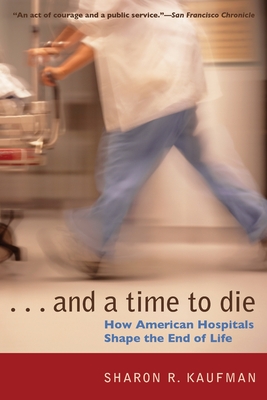
And a Time to Die: How American Hospitals Shape the End of Life
Description
Over the past thirty years, the way Americans experience death has been dramatically altered. The advent of medical technology capable of sustaining life without restoring health has changed where, when, and how we die. In this revelatory study, medical anthropologist Sharon R. Kaufman examines the powerful center of those changes: the hospital, where most Americans die today. She deftly links the experiences of patients and families, the work of hospital staff, and the ramifications of institutional bureaucracy to show the invisible power of the hospital system in shaping death and our individual experience of it. In doing so, Kaufman also speaks to the ways we understand what it means to be human and to be alive.
“An act of courage and a public service.”—San Francisco Chronicle
“This beautifully synthesized and disquieting account of how hospital patients die melds disciplined description with acute analysis, incorporating the voices of doctors, nurses, social workers, and patients in a provocative analysis of the modern American quest for a ‘good death.’”—Publishers Weekly
“Kaufman exposes the bureaucratic and ethical quandaries that hover over the modern deathbed.”—Psychology Today
“Kaufman’s analysis illuminates the complexity of the care of critically ill and dying patients [and] the ambiguity of slogans such as ‘death with dignity,’ ‘quality of life,’ and ‘stopping life support.’ . . . Thought-provoking reading for everyone contemplating the fate of us all.”—New England Journal of Medicine
Praise for And a Time to Die: How American Hospitals Shape the End of Life
“An act of courage and a public service.”<San Francisco Chronicle>
— San Francisco Chronicle
“An outstanding, timely examination of how and why people die or are kept alive in U.S. society. . . . You finish the book with a sense that although the future remains unknown, you are at least better informed and perhaps better able to cope with the inevitable.”
— USA Today
“This beautifully synthesized and disquieting account of how hospital patients die melds disciplined description with acute analysis, incorporating the voices of doctors, nurses, social workers, and patients in a provocative analysis of the modern American quest for a ‘good death.’”<Publishers Weekly>
— Publishers Weekly
“Kaufman’s analysis illuminates the complexity of the care of critically ill and dying patients [and] the ambiguity of slogans such as ‘death with dignity,’ ‘quality of life,’ and ‘stopping life support.’ . . . Thought-provoking reading for everyone contemplating the fate of us all.”
— New England Journal of Medicine
“This is ethnography at its best. . . . [The author's] quietly powerful book, which needs to be read by both family caregivers and medical professionals, belongs on the shelves of public, academic, and medical libraries.”
— Library Journal
“Kaufman exposes the bureaucratic and ethical quandaries that hover over the modern deathbed.”
— Psychology Today
"This is a book about slow dying in hospitals. . . . Through 27 case studies, Kaufman is able to describe and explore these intricacies thoroughly and with great success."
— Allan Kellehear
"[The] style of this book makes it accessible and enjoyable and takes the reader into the world of the modern US hospital that is the place where most Americans die. . . . Highly recommended for anyone interested in end of life care in institutional settings."
— Jacqueline H. Watts
"Through 27 compelling narratives, [the author] describes with uncanny accuracy and a gift for vivid detail the complex and often troubled dance that patients, families, physicians, nurses, and hospitals engage in as death nears. The book illuminates the central dilemma of dying in contemporary hospital culture."
— Paul B. Bascomb
